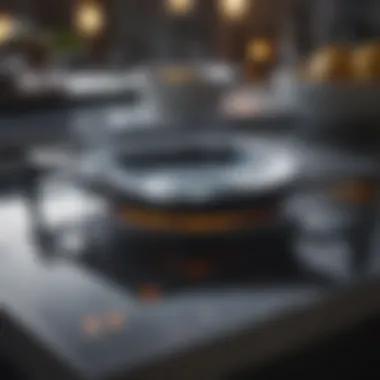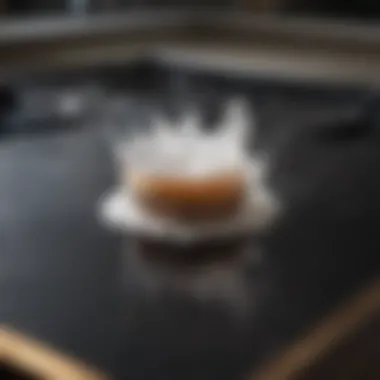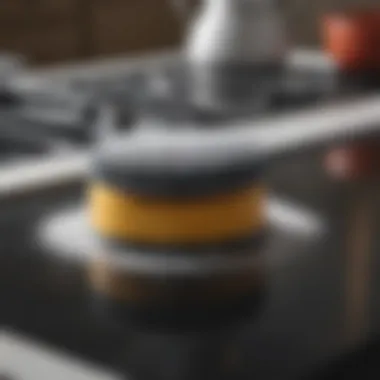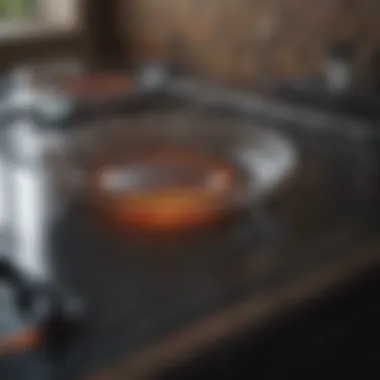Mastering Glass Cooktop Cleaning with Baking Soda


Intro
Keeping a glass cooktop clean can be quite a challenge. It is not only crucial for aesthetics but also for maintaining functionality and hygiene in the kitchen. The surface is often exposed to spills, burns, and residues from cooking, prompting the need for a reliable cleaning method. In this article, we will discuss the effective method of cleaning your glass cooktop using baking soda. This common household item is not just limited to baking; it can also serve as a remarkable cleaning agent.
Through this guide, homeowners and cooking enthusiasts will find a step-by-step approach to tackle tough stains and maintain their cooktop with minimal chemicals. By employing baking soda, you can achieve a clean surface that shines, while ensuring that harmful chemical cleaners are avoided.
Additionally, preventative measures will be highlighted to aid in maintaining the cooktop's appearance over time. Proper care can prolong the life of your appliance, ultimately saving you time and money on replacements. Let's delve into this efficient cleaning technique.
Understanding Glass Cooktops
Understanding glass cooktops is essential for anyone looking to maintain one effectively. These surfaces not only enhance the aesthetic of a kitchen but also pose unique cleaning challenges. Familiarizing oneself with the characteristics of glass cooktops can prevent common mishaps and prolong their life.
Preamble to Glass Cooktops
Glass cooktops have gained popularity due to their sleek design and modern appeal. Typically made of tempered glass, they provide a smooth surface that is easy to clean compared to traditional metal burners. The ability to monitor cooking processes visually is another significant advantage. Understanding the specific features of glass cooktops will aid users in maximizing their performance and longevity.
Common Materials and Features
Most glass cooktops utilize ceramic or glass materials, which contribute to their efficiency. These materials can withstand high temperatures and resist scratches if used correctly. Features often include touch controls for precise temperature settings, while some models offer induction technology. Knowing these features enables users to choose the appropriate cleaning techniques and products to avoid damage.
Advantages of Glass Cooktops
The benefits of glass cooktops extend beyond appearance. They are typically easier to clean, minimizing food residue buildup and ensuring a more sanitary cooking environment. Unlike traditional stovetops, glass cooktops provide a flat surface that can accommodate various cookware sizes without risk of spillage into burners. Furthermore, the ease of monitoring cooking progress through a transparent surface enhances cooking efficiency.
In addition, glass cooktops often offer energy efficiency by allowing even heat distribution, which facilitates faster cooking. This combination of aesthetics, practicality, and performance makes understanding glass cooktops crucial for maintenance and cleaning.
The Challenge of Cleaning.
Cleaning glass cooktops might seem straightforward, but it involves unique challenges. Knowing how to tackle these obstacles ensures that your cooktop stays clean without risking damage. Glass cooktops are known for their sleek, modern appearance. However, they are particularly susceptible to stains and residues that can accumulate over time. Understanding these issues can help in selecting the most effective cleaning methods.
Stains and Residues on Glass
Various stains frequently appear on glass cooktops. These may originate from food spills during cooking, burnt leftovers, or even heat marks. The composition of different foods also contributes to the variety of stains. For instance, sugary substances can become sticky and harden, while grease can create a slippery film. Each type of stain has its unique challenges. Regular cleaning is essential to prevent some substances from becoming engrained. Otherwise, they can become difficult to remove and may affect the cooktop's appearance. The materials used for cooking can even interact with the cooktop surface if they are not cleaned promptly, leading to more profound discoloration or damage over time.
Potential Damage from Improper Cleaning
One of the most significant risks associated with cleaning glass cooktops is the potential for damage. The use of abrasive cleaners or scrubbers can scratch the surface. Similarly, the wrong type of scraper can lead to irreversible harm. Over time, inappropriate cleaning methods can compromise the integrity of the glass. This damage can lead to cracking or weakening the cooktop, increasing the risk of breakage. Therefore, while cleaning might seem simple, it requires careful consideration of methods and materials.
Why Traditional Cleaners Can Fall Short
Many people rely on traditional cleaners for household tasks, but they may not be suitable for glass cooktops. Chemical-based cleaners can leave residues that are hard to fully remove. They may also react negatively with the surface, which could lead to dullness or discoloration. Furthermore, these cleaners often have strong scents and can pose health risks if inhaled or ingested unintentionally. In contrast, baking soda offers a gentler alternative. It provides effective cleaning without the harsh chemicals, making it safer for both users and the cooktop.
"The key to maintaining a glass cooktop lies in recognizing the specific cleaning challenges it presents."
Using baking soda can help homeowners avoid these pitfalls, allowing for a cleaner surface while preserving the cooktop's condition.
Benefits of Using Baking Soda
Baking soda is more than just a common ingredient found in kitchens. Its significance extends into the realm of cleaning, especially when dealing with glass cooktops. Understanding the advantages of using baking soda can significantly enhance both the cleaning experience and the results. This section looks into the natural and non-toxic properties of baking soda, its cost-effectiveness, and its versatility beyond cleaning cooktops. Each of these elements plays a crucial role in why baking soda is a preferred cleaning agent for many homeowners.
Natural and Non-Toxic Properties


One of the primary reasons for choosing baking soda as a cleaning agent is its natural and non-toxic characteristics. Baking soda, or sodium bicarbonate, does not contain harsh chemicals that could harm the environment or pose a risk to health. This property is especially appealing for those concerned about using chemical cleaners in their homes, particularly in areas where food is prepared.
- Safety for Family: Using baking soda reduces the risk of chemical exposure for children and pets. Traditional cleaners often include toxic substances that can lead to health issues if ingested or inhaled.
- Environmental Friendly: With increasing awareness about the ecological impacts of household products, baking soda stands out as an eco-friendly choice. It decomposes naturally and does not contribute to landfill waste like many commercial cleaners.
Overall, the natural aspect of baking soda aligns well with modern living preferences that prioritize safety and sustainability.
Cost-Effectiveness of Baking Soda
In addition to its safety, baking soda is an economically wise choice for maintaining glass cooktops. The affordability of baking soda enhances its appeal as a cleaning agent.
- Low Cost: Unlike specialized glass cleaning solutions, baking soda is generally inexpensive and widely available at supermarkets or online. A small quantity goes a long way, making it a budget-friendly option in household cleaning.
- Multiple Uses: Beyond cleaning glass cooktops, baking soda serves various purposes. It can deodorize, soften water, and even react with other ingredients in baking. Hence, purchasing a single product for multiple uses results in cost savings over time.
In essence, baking soda is not only effective but also an economical choice for regular kitchen maintenance.
Versatility Beyond Cooktops
Baking soda's usability expands beyond just cleaning glass cooktops. This versatility makes it an essential product in any household.
- Cleaning Agent: Besides cooktops, baking soda can be used to clean sinks, countertops, and even kitchen cabinets. Its mildly abrasive nature makes it effective at removing grime without damaging surfaces.
- Laundry Helper: Mixing baking soda with laundry detergent can enhance cleaning power, helping to deodorize clothes while maintaining brightness.
- Odor Neutralizer: Baking soda is well-known as a natural deodorizer. It can absorb unwanted odors in refrigerators or any room, making it a practical choice for everyday use.
The broad range of applications for baking soda solidifies its status as a multi-tasker, further emphasizing its importance in any cleaning arsenal.
Baking soda is a powerful, budget-friendly, and eco-conscious tool for refined cleaning tasks in your home.
By recognizing these key benefits, homeowners can make informed decisions on how to maintain their glass cooktops and other kitchen appliances effectively.
Preparing for Cleaning
Before diving into the cleaning process, it is crucial to prepare adequately. This preparation helps in ensuring an efficient and effective cleaning outcome. A clean cooktop not only looks inviting but also contributes to a hygienic cooking environment. Additionally, understanding what materials and precautions are necessary can streamline the cleaning process, minimizing potential mishaps.
Gathering Necessary Materials
To clean a glass cooktop with baking soda, you need to gather specific materials. Here’s a concise list of what you will need:
- Baking soda: This is the primary cleaning agent due to its mild abrasive qualities and natural cleaning properties.
- Water: It is essential for creating a paste with baking soda and for rinsing afterward.
- Soft cloth or sponge: Use a non-abrasive cloth to avoid scratching the glass surface.
- Spray bottle: If you choose to create a vinegar solution for additional cleaning, a spray bottle can be useful.
- Plastic scraper or spatula: This helps in removing tough residues without damaging the cooktop.
Make sure to have these materials ready before you begin cleaning. Having everything on hand allows for a smooth process and prevents interruptions.
Safety Precautions to Consider
Cleaning a glass cooktop requires not only the right tools but also a focus on safety. Here are some essential safety precautions:
- Cool Down: Ensure the cooktop is completely cool to prevent burns. Touching a hot surface can lead to serious injuries.
- Ventilation: If you will use vinegar or any strong cleaner, ensure that the kitchen is well-ventilated. Opening windows or turning on a fan helps disperse any strong odors.
- Avoid Abrasive Pads: Do not use steel wool or harsh scrubbers as these can scratch the glass surface, leading to permanent damage.
- Keep Children Away: If you are cleaning while children are present, ensure they are at a safe distance from the work area.
Implementing these safety measures will not only create a safer environment but also protect the integrity of your cooktop, ensuring it remains in good condition for years to come.
Step-by-Step Cleaning Process
The process of cleaning a glass cooktop should not be taken lightly. Glass cooktops are not just about aesthetics; they're functional kitchen appliances that require regular maintenance. Proper techniques can ensure their longevity and appearance. Adopting a step-by-step approach simplifies the cleaning task, making it less daunting. Following this method not only maximizes the effectiveness of the clean but also protects the surface from potential scratches and damage. Each step contributes to a holistic cleaning experience, turning a challenging task into a manageable one.
Initial Surface Cleaning


Before diving into deeper cleaning, an essential first step is to perform an initial surface cleaning. This step is crucial because it removes loose dirt and debris, preparing the cooktop for targeted cleaning. Begin by using a damp microfiber cloth or sponge to wipe down the surface. Hot water works best, as it helps in lifting grime while also cooling down the cooktop if it has recently been used. This preliminary action not only saves time in the long run but also helps in preventing scratches that might occur if debris is scrubbed into the glass.
Creating a Baking Soda Paste
Creating a baking soda paste is simple yet effective. Baking soda, known for its gentle abrasiveness, helps lift stains without scratching the cooktop. To prepare the paste, take about three tablespoons of baking soda and add water slowly until you achieve a thick consistency. The proper thickness is vital, as it allows the paste to adhere to the stains without running off. This paste is versatile and enhances cleaning efficiency, making it an excellent choice for various types of stains. The consistency should be similar to toothpaste, ensuring it sticks well to the surface.
Applying the Paste to Stains
Once the paste is ready, the next step is to apply it directly to the stains or tough spots on the cooktop. Use a spatula or your hands (make sure they're clean) to spread the paste evenly. It is recommended to apply a generous amount over the affected areas. Allow the paste to sit for at least ten to fifteen minutes. This waiting period is crucial because it allows the baking soda to penetrate the stains, making them easier to remove. This process not only helps in breaking down stubborn residues but also preps the surface for the next scrubbing step.
Scrubbing Techniques
After the paste has had time to work its magic, scrubbing becomes necessary. Using a soft cloth or non-abrasive sponge, gently scrub the area in circular motions. Focus on one section at a time to ensure thorough cleaning. Avoid using steel wool or any harsh scrubbers, as these can cause scratches on the glass surface. Instead, opt for softer materials that will effectively clear the residue without harming the cooktop. Ensure you are applying even pressure, as too much force may cause damage, while too little may not yield the desired results.
Final Rinse and Drying
The final step in the process involves rinsing away the baking soda paste. Using a clean damp cloth, wipe away all the baking soda residue, ensuring no gritty particles remain. It is important to change the rinse water frequently to avoid reapplying dirt. Once rinsed, use a dry cloth or paper towel to wipe the surface until it's shiny and streak-free. This last action not only enhances the appearance of the cooktop but also helps in preventing water spots and stains from forming. Proper drying is essential, as residual moisture can attract dirt and lead to future stains.
Maintaining Your Glass Cooktop
Maintaining a glass cooktop is essential for preserving its aesthetic and performance. Regular upkeep not only enhances the appliance's appearance but also prolongs its lifespan. An unclean cooktop can accumulate residues, which can affect cooking efficiency and result in uneven heat distribution. When a cooktop is well-maintained, it also reflects positively on the overall kitchen environment, making cooking more enjoyable.
Regular Cleaning Schedule
Establishing a regular cleaning schedule is crucial. Frequent cleaning prevents tough stains and residues from building up. Aim to clean your cooktop after each use or at least daily. This avoids the need for harsh scrubbing later. After cooking, allow the surface to cool, then wipe off any spills with a damp cloth. Use a little bit of baking soda mixed with water for tougher stains. This method keeps the cooktop smooth and shiny.
Tips for Preventing Tough Stains
Preventing stains is simpler than removing them once they have settled. It is beneficial to use cookware that has smooth, flat bottoms to minimize scratches and residues. Always avoid dragging pots across the surface.
- Use protective mats: These can be placed on the cooktop during cooking to catch spills.
- Covering pots while cooking: This reduces splattering and, consequently, staining.
Furthermore, promptly cleaning any spills, especially sugary or acidic substances, can be effective in preventing tougher stains from forming.
Protective Measures to Implement
Several protective measures can be implemented to ensure your glass cooktop remains in top condition.
- Install a cooktop protector: These are designed to act as a barrier, protecting the glass from scratches and burns.
- Use the right cleaning tools: Soft cloths and non-abrasive scrubbing pads help prevent damage to the surface.
- Avoid high heat settings: Constant exposure to extreme temperatures can weaken the glass over time.
By integrating these protective measures into your cooking routine, you can greatly reduce the chances of unanticipated damage to your glass cooktop, ensuring it remains functional and visually appealing.
"An ounce of prevention is worth a pound of cure."
In summary, maintaining a glass cooktop involves a combination of regular cleaning, stain prevention techniques, and protective measures. When both care and caution are taken, your glass cooktop will serve you well for many years.
Dealing with Specific Stain Types
In the maintenance of glass cooktops, addressing specific types of stains is crucial. Different stains require tailored strategies for effective removal. Ignoring this can lead to permanent damage and unattractive appearances. Understanding these specific stain types and how to deal with them not only enhances your cooktop's longevity but also maintains its aesthetic value. The following sections will provide insights into common stains such as burnt food residue, hard water marks, and grease or oil stains.
Residue from Burnt Food


Burnt food residue often poses a significant challenge when cleaning glass cooktops. When food particles get burned onto the surface, they can harden, making them particularly stubborn to remove. The importance of tackling burnt food residue lies in the fact that it can not only mar the appearance of the cooktop but also negatively affect cooking performance. If not addressed promptly, these residues can lead to scratching or other forms of physical damage.
To effectively clean burnt food stains, start by applying a baking soda paste directly to the affected area. The alkaline properties of baking soda can help to soften the burnt residue, allowing for easier removal. A gentle scrubbing action using a non-abrasive sponge can also prove effective in this case.
White Marks from Hard Water
Hard water can leave unsightly white marks on your glass cooktop, which can be a frustrating issue for many homeowners. These marks are primarily composed of mineral deposits that accumulate over time with regular use. Addressing these stains is vital for maintaining the clarity and shine of the cooktop's surface. White marks can not only detract from the cooktop's visual appeal but also create a perception of neglect in kitchen maintenance.
To eliminate hard water stains, a solution of equal parts vinegar and water can be applied to the affected areas. Vinegar is an excellent natural cleaner that interacts with minerals and helps dissolve these deposits. Following this, a light scrub with a soft cloth will restore the shine of your cooktop effectively.
Grease and Oil Stains
Grease and oil stains are among the most common issues encountered with glass cooktops, particularly after frying or cooking fatty foods. These stains can create a slick surface that not only appears untidy but can also affect food safety. Over time, grease can become baked onto the surface, making it more difficult to clean. Hence, proper and timely removal is important for aesthetics and hygiene.
To tackle grease stains, sprinkle some baking soda directly on the stained area. Dampen it with warm water, allowing the mixture to sit for a few minutes. Afterward, use a gentle scrubbing motion with a cloth. This should lift the grease effectively. Alternatively, a commercial degreaser can also be effective, but it is recommended to use the least abrasive solution to safeguard the cooktop's surface.
"Regularly addressing specific stain types not only preserves the integrity of your glass cooktop but also contributes to a better cooking experience."
Overall, effective cleaning involves understanding the unique characteristics of each type of stain and applying suitable methods. Special care ensures both functionality and the aesthetic appeal of your glass cooktop.
Exploring Alternative Cleaning Methods
In a world where diverse cleaning solutions are readily available, it is wise to consider a range of alternatives when maintaining your glass cooktop. While using baking soda is highly effective, exploring other methods can offer unique benefits. These methods might cater to specific stains, provide different efficiency levels, or even have varied costs associated with them. A thorough review of alternative cleaning techniques enables users to tailor their cleaning approach according to individual needs and preferences.
Commercial Cleaners
Commercial cleaners, designed specifically for glass cooktops, often provide targeted solutions that remove stubborn stains. These cleaners come in various forms such as sprays, creams, and wipes. They usually have ingredients that enhance their effectiveness against kitchen residues such as baked-on grease or food particles.
However, there are important considerations to keep in mind. First, the chemical composition in many commercial products can be harsh. This can potentially affect not only the cooktop's surface but also the environment and the user's health. It is advisable to read labels carefully and consider opting for brands that prioritize non-toxic formulations.
"Selecting a cleaner requires understanding both the strengths and the potential risks associated with its ingredients. Always prioritize safety and efficacy.”
Vinegar and Water Techniques
Vinegar and water is another simple and effective cleaning method. This technique utilizes the natural acidity of vinegar to dissolve dirt and stains. A mixture typically comprises equal parts of vinegar and water, which can be applied directly onto the cooktop. After spraying this solution, it is best to let it sit for a few minutes. This allows the vinegar to penetrate and break down residues. Then, use a soft cloth or sponge to wipe away the stains. This method is not only economical but also free from harmful chemicals, making it a popular choice for those preferring eco-friendly cleaning.
Use of Scrapers and Blades
Scrapers and blades are practical tools when dealing with tough stains that baking soda alone might not handle. A specialized cooktop scraper, which is designed for this purpose, uses a sharp edge to gently lift and remove hardened residues without scratching the glass surface. Using a scraper requires a delicate touch, as excessive pressure can lead to damage. When used correctly, this method can be very effective, especially for burnt food remnants or stubborn marks. Always ensure the scraper is held at an angle to protect the surface of the cooktop.
In concluding this section, understanding alternative cleaning methods broadens the toolkit of techniques available to maintain your glass cooktop. Each method comes with its benefits and considerations. Ultimately, choosing the right method hinges on personal preferences, types of stains encountered, and commitment to safety.
Ending
Summary of Key Points
In summary, key points include the following:
- Understanding the nature of glass cooktops: Identifying the common stains and issues that can arise, and recognizing the materials used in their construction.
- Advantages of baking soda: Utilizing a natural and non-toxic cleaning agent for effective dirt and stain removal without harmful side effects.
- Step-by-step processes: Detailed guidance on preparing for cleaning, applying techniques, and ensuring proper maintenance to reduce the occurrence of tough stains in the future.
- Alternative methods explored: An overview of additional cleaning strategies using commercial products, vinegar solutions, and mechanical scrapers.
Final Thoughts on Glass Cooktop Care
With proper care and understanding, glass cooktops can remain a focal point in any kitchen for years. Emphasizing minimal use of harsh chemicals not only aligns with a more environmentally friendly approach but also facilitates user safety.
As noted, regular maintenance, understanding different types of stains, and employing baking soda can remarkably simplify the cleaning process while protecting the integrity of the cooktop surface. Being informed about these techniques ensures a cleaner cooking experience and contributes to the overall aesthetic of the kitchen.
Proper management of your glass cooktop can prevent the buildup of tough stains and extend the life of the appliance, making it a valuable investment in your home.
By adopting these practices, users can confidently showcase their clean glass cooktops, reflecting the commitment to both aesthetic appeal and functionality in their cooking spaces.



